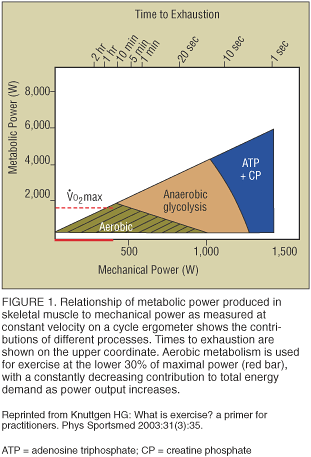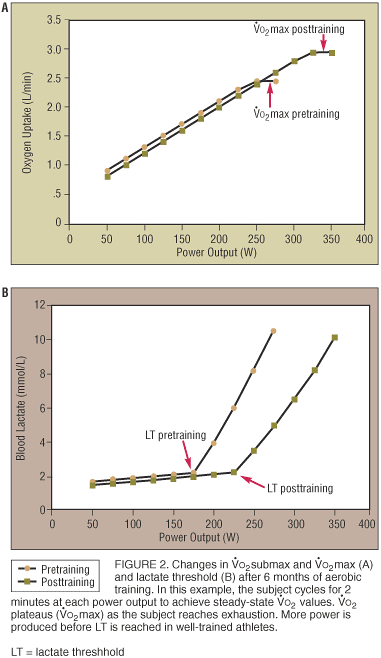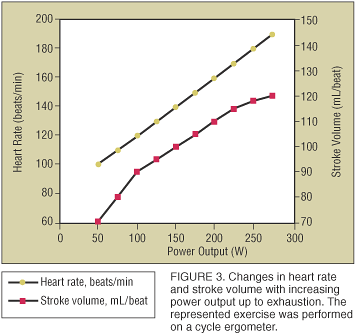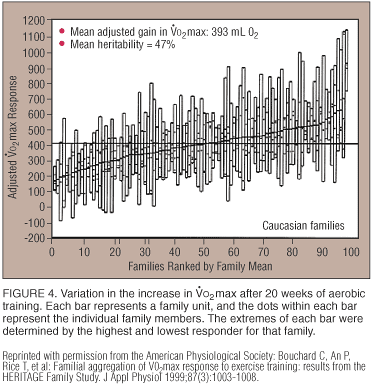
Aerobic Exercise and Endurance
Improving Fitness for Health Benefits
Jack H. Wilmore, PhD
Exercise Physiology Series Editor:
Howard G. Knuttgen, PhD
THE PHYSICIAN AND SPORTSMEDICINE - VOL 31 - NO. 5 - MAY 2003
In Brief: Clinicians who understand how the body responds to exercise, how aerobic training improves cardiovascular fitness, and the benefits and principles of prescribing aerobic exercise can effectively encourage patients to become active and optimize programs for those already active. Patients who are active at an early age and who continue to enjoy active lifestyles as adults will attenuate the normal losses in cardiovascular endurance, strength, and flexibility that accompany aging and sedentary living, thereby maintaining greater independence throughout their life spans.
Over the past 15 years, the medical community has become increasingly aware of the important role physical inactivity plays in the development of many chronic degenerative diseases.1-6 Unfortunately, most physicians have had little or no exposure to exercise physiology in their medical training, particularly as it relates to disease prevention and health promotion. Important details about aerobic exercise include the physiologic responses to an acute bout of exercise, chronic adaptations to training, prescription of training programs, and health benefits.
The broad overview for this series (see "What Is Exercise: A Primer for Practitioners") discussed the basic concepts of exercise physiology and provided a summary of the relationship between metabolic power and mechanical power (figure 1). Exercise in which aerobic metabolism accounts for most of the energy needs of active skeletal muscle cells is performed at the lower end of the scale (up to 30% of maximal power), where power output is relatively low and time to exhaustion is high.

Acute Response to Exercise
To study how the body responds to an acute bout of exercise, we can have the subject exercise under one of two test conditions:
- A single-stage test at a constant power output, allowing us to observe a steady-state response to a given power output; or
- A multistage test with increasing power outputs, each stage generally 1 to 3 minutes long (ie, a graded exercise test).
For this discussion, we will use the graded exercise test as our model and the cycle ergometer as the mode of exercise. Use of a cycle ergometer enables precise quantification of power output and physiologic values that are independent of body size.
Neuromuscular Response
Skeletal muscle is composed of a mixture of muscle fibers, generally classified as either type 1 (slow-twitch fibers with high aerobic capacity) or type 2 (fast-twitch fibers with high glycolytic capacity). Type 2 fibers are further distinguished as type 2a fibers, which have moderate aerobic capacity, and type 2b fibers, which have low aerobic capacity. Additional type 2 subtypes have been identified, but they constitute a small percentage of type 2 fibers.
During aerobic activity, the nervous system recruits primarily type 1 muscle fibers. A motor unit is defined as the motor neuron and the specific muscle fibers it innervates. Motor units are unique in that they contain either type 1 or type 2 muscle fibers, but not both. In fact, the motor neuron appears to be the deciding factor as to whether a muscle fiber will be type 1 or type 2. Type 1 motor neurons are small and innervate between 10 and several hundred type 1 fibers. Type 2 motor neurons are large and innervate from several hundred up to a thousand or more type 2 fibers.
Motor units are recruited in a specific order, determined by the "size principle," as muscle force requirements increase. The smaller motor neurons are recruited first, so, for very low power outputs, the body recruits predominantly type 1 motor units. Type 2 motor units are added at higher power outputs; type 2a motor units are recruited first, then type 2b motor units for the higher power outputs. All motor unit types are recruited at peak power outputs.
Metabolic Response
As the power output increases on the cycle ergometer, the metabolic response increases linearly. The metabolic rate is closely related to the body's oxygen consumption, or uptake (VO2). As power output increases, there is a corresponding increase in VO2 (figure 2A). Also plotted in this figure is the blood lactate concentration for each power output (figure 2B). Note that VO2 increases only up to a point and then plateaus (VO2max) as the subject reaches exhaustion. This plateau is not always achieved; therefore, many scientists prefer to use the term VO2peak. For this article, I use VO2max, because it is considered to be the best physiologic marker of aerobic endurance, or aerobic power.

Blood lactate concentrations (see figure 2B) remain reasonably stable at about, or slightly above, resting levels for the first part of the test. As power output continues to increase, however, blood lactate concentrations eventually start to increase above resting levels to a point called the lactate threshold (LT), a point at which more lactate is produced than the body is able to clear. Interestingly, the race pace for endurance runners, cyclists, and swimmers is set very close to their individually determined LTs.
Cardiovascular and Respiratory Responses
The cardiovascular and respiratory systems must support the body's metabolic needs and make appropriate responses as the need for oxygen increases.
The Fick equation (VO2 = cardiac output X a-vO2diff) expresses the relationship between oxygen consumption, cardiac output (heart rate times stroke volume), and the arterial and mixed venous concentrations of oxygen (a-vO2diff).7 From the Fick equation, we see that, for VO2 to increase, cardiac output, the arterial-mixed venous oxygen difference, or both need to increase as power output increases.
For many years researchers assumed that stroke volume increased until the subject reached about 40% to 60% of VO2max, then plateaued. However, recent data suggest that stroke volume continues to increase up to maximal power output, particularly in highly trained subjects (figure 3). Cardiac output tends to increase linearly, in response to the increased need for oxygen delivery to the active muscles. The proportion of the cardiac output going to skeletal muscle increases from about 20% at rest to over 80% during high-intensity exercise.

The oxygen content of the arterial blood changes little as power output increases to maximal levels, although it can decrease at very high exercise intensities in highly trained endurance athletes and in cardiac and pulmonary patients. The mixed venous oxygen content, reflecting blood in the right heart or pulmonary artery, decreases with increasing power output, because more oxygen is being removed from the blood in the active muscles, and an increasing percentage of the cardiac output has been redistributed to active muscles. The net result is a progressive increase in the a-vO2diff.
The respiratory system must also respond to the increasing need for oxygen in the active muscles as power output increases. Ventilation, which is the product of respiratory frequency and tidal volume, increases in proportion to the increase in power output. Resting ventilation is about 10 L/min and can increase to well over 100 L/min at maximal power output. Elite rowers have attained values in excess of 200 L/min. The increase in ventilation is accomplished by increases in both respiratory rate and tidal volume.
Adaptations to Aerobic Training
When a sedentary person becomes more active, substantial physiologic adaptations occur. The magnitude of these adaptations is determined by the volume and intensity of training: the greater the volume and intensity, the greater the adaptation. The adaptations also tend to be highly specific to the mode or type of training. For example, aerobic swim training will improve aerobic capacity, but it will have little or no effect on the ability to run, cycle, or cross-country ski. Some general central adaptations occur, but most of the key adaptations are in the specific muscles used during training, with little carryover to muscles that are not used. This concept is known as the specificity of training.
Neuromuscular. Aerobic training produces substantial adaptations within skeletal muscle. First, the cross-sectional area of type 1 muscle fibers increases by up to 25%, but type 2a or 2b fiber area apparently does not increase. A transition of type 2b to type 2a fibers can occur, and recent research even indicates a transition of type 2a to type 1 fibers. This results in a smaller percentage of type 2b fibers, little or no change in the percentage of type 2a fibers, and a slight increase in the percentage of type 1 fibers. The number of capillaries increases within the trained muscle, as does the ratio of capillaries to muscle fibers. Trained muscle also has an increase in myoglobin content, the number and size of mitochondria, and a large increase in oxidative enzyme activity. The magnitude of these changes appears to be independent of sex, race, and age.
Metabolic. VO2max increases about 15% to 25% with aerobic training (see figure 2A). Early studies suggested that women and older people had smaller increases compared with men and younger people. However, more recent studies with larger subject populations indicate that the percentage increase is independent of sex, race, and age. This increase in VO2max is primarily the result of an increase in blood flow to the active muscle mass because of an increase in maximal cardiac output. Changes within muscle also contribute to this increase, primarily the increases in capillarization, myoglobin, and oxidative enzyme activity.
One of the most interesting research findings of the past 10 years is the wide range of responses among subjects. Some subjects experience little or no improvement in VO2max with aerobic training (low responders), and others experience changes of 50% or more (high responders). In the HERITAGE Family Study,8 742 subjects representing more than 200 families completed a 20-week supervised aerobic training program. Using cycle ergometers three times per week, subjects began at an intensity of 55% of VO2max for 35 minutes and gradually increased to 50 minutes at 75% of VO2max for the last 6 weeks. Every subject completed exactly the same training program, yet the increase in VO2max ranged from 0% to over 50% (figure 4). Maximal heritability estimates for both VO2max and the response of VO2max to training are about 50%.

Aerobic training also increases the LT (see figure 2B). The LT occurs at a higher percentage of VO2max. Further, since VO2max is also increased, the LT is achieved at a much higher power output on a cycle ergometer or speed on a treadmill. This explains the ability of trained people to compete at a much higher steady state power output or speed in endurance activities (ie, race pace). The physiologic explanation for this increase in LT has not been totally resolved. It appears to occur because of an increase in lactate clearance, a decrease in lactate production, or both.
Cardiovascular. Aerobic training results in a substantial change in the cardiovascular responses to exercise. The cardiovascular changes are driven by an increase in plasma volume of about 20%. Red blood cell mass also increases, but to a lesser extent, resulting in a decreased hematocrit. The lower blood viscosity and higher red cell content provides enhanced oxygen transport.
The increase in total blood volume allows an increase in stroke volume, largely because of an increase in venous return and a greater end-diastolic volume. Secondarily, left ventricular contractility is enhanced, caused by myocardial hypertrophy and a reduced total peripheral resistance, resulting in a reduced end-systolic volume. Associated with the increase in stroke volume is a decrease in heart rate, both occurring at rest and during submaximal exercise at the same power output. At maximal exercise, maximal stroke volume is increased, but maximal heart rate, with few exceptions, remains unchanged.
As a result of these changes in stroke volume and heart rate, cardiac output tends to be unchanged at rest, unchanged or slightly reduced at the same submaximal power output, and greatly increased at maximal power output. As mentioned earlier, cardiac output is driven primarily by the need for oxygen. At the same submaximal power outputs posttraining, the oxygen cost (actual VO2) is often reduced because of an increased metabolic or mechanical efficiency. Consequently, the cardiac output will decrease proportionately. The a-vO2diff can also increase, thus reducing cardiac output for the same power output.
Respiratory. Aerobic training substantially changes the respiratory response to exercise. Ventilation remains about the same at rest and during submaximal exercise at the same power outputs but increases rather dramatically at maximal power output. This is accomplished by an increase in both maximal respiratory rate and maximal tidal volume.
The Aerobic Exercise Prescription
When prescribing aerobic exercise, the following factors must be considered: mode of exercise, duration of each session, frequency, and intensity. The patient's initial fitness level, age, personal goals (eg, health, fitness, competitive performance), and methods for monitoring the intensity of exercise are also important considerations.
Mode, duration, and frequency. The current position stand of the American College of Sports Medicine (ACSM),9 revised in 1998, describes the key components of exercise prescription for developing and maintaining aerobic fitness. The ACSM recommends that the mode of activity should use large muscle groups, maintain a continuous pace, and be rhythmical and aerobic in nature (eg, walking, hiking, jogging, running, cycling, cross-country skiing, rowing, swimming, skating, aerobic dance, or stair climbing). Even endurance sports can be used. The duration should be 20 to 60 minutes of continuous or intermittent activity (not less than 10-minute bouts), longer for low-intensity activity and shorter for high-intensity activity. The frequency of training should be three to five times per week.
Intensity. Of the exercise prescription factors, intensity is likely the most important. In both training and detraining studies, intensity has been identified as the most important factor for the magnitude of the increase or decrease in aerobic fitness (VO2max). Further, with older and high-risk individuals, intensity must be monitored carefully to make certain they are training at levels that will not only provide a training stimulus, but also be safe. For healthy people, intensity should vary from 40% or 50% to 85% of VO2max reserve (VO2max reserve = VO2max - VO2rest). Since most people do not have access to a laboratory where they can have their VO2max measured, exercise is generally prescribed on the basis of heart rate reserve.
Exercise intensity should be prescribed within a given range, with the high and low boundaries determined by the patient's age and fitness level. The patient exercises at varying intensities within the range--hard enough to provide a training response at the low end but within the upper limit to be safe. For older and less fit people, exercise intensity should begin at the low end of the range.
Intensity can be monitored by heart rate (more accurate) or by rating perceived exertion (more natural). When using heart rate, the training intensity ranges are prescribed on the basis of heart rate reserve (HRR), where HRR = HRmax - HRrest. HRmax can be estimated from the equation: HRmax = 208 - (0.7 X age).10 To calculate a training intensity at 60% of VO2max, the formula HRR60% = HRrest + 60% of HRR is used. For example, for an HRrest of 75/min and an estimated HRmax of 175/min, HRR60% = 75 + [0.60 X (175 - 75)] = 75 + (0.60 X 100) = 75 + 60 = 135/min. The upper range is calculated using the same procedure.
Additional factors. When prescribing exercise, the total physical fitness of the individual, not just aerobic fitness, must be considered. Optimal strength and flexibility must be maintained, especially for the aging population in whom a reduction in strength and flexibility can lead to a loss of independence. Starting early in life with a balanced fitness program that includes aerobic, strength, and flexibility activities will likely lead to a better quality of life throughout the lifespan.
The age and sex of the participant are generally not major factors. Women and men have similar responses to the same exercise prescription, and the exercise intensity is established relative to each individual's aerobic power, thus accounting for any differences in the initial fitness level. The same is true for age, although it would be prudent to be more conservative in establishing the initial intensity, duration, and frequency of exercise, and the rate of progression, for older patients.
Health Benefits of Aerobic Training
Physical inactivity is a major health concern today. The association of an inactive lifestyle with an increased risk of chronic degenerative diseases is well understood. Risk reduction can occur at levels of exercise below those discussed here, levels that are intended to promote and maintain aerobic fitness. This was made clear in the consensus statements published by the Centers for Disease Control and Prevention and the ACSM,3 the National Institutes of Health,4 and the surgeon general's report released in 1996.5
Physical activity plays a major role in reducing the risk for cardiovascular diseases, including coronary artery disease, stroke, and hypertension. Epidemiologic studies show that the risk of coronary artery disease associated with physical inactivity is nearly the same as the risk associated with smoking, abnormal lipid levels, and hypertension. However, inactivity is about two to three times more prevalent than is smoking, abnormal lipid levels, or hypertension.
Physical activity is also important in the prevention of the two primary metabolic diseases: obesity and diabetes. The prevalence of overweight and obesity in the United States has increased dramatically in the past 20 years. In 2002, an estimated 67% of men and 62% of women were overweight or obese (body mass index [BMI] ≥ 25.0 kg/m2). The problem is much more significant in Mexican American men and women and black women.11 Similar trends have been reported in children and adolescents. Using the criteria of ≥ 95th percentile for BMI, between 1976-1980 and 1999-2000, the prevalence of overweight in 6- to 11-year-old children increased from 6.5% to 15.3%, and in 12- to 19-year-old adolescents from 5.0% to 15.5%. The largest increases were in blacks and Mexican Americans.12
Diabetes is also increasing at an alarming rate, in concert with the increase in obesity. Type 2 diabetes (formerly called adult-onset diabetes) is beginning to appear in children, and its prevalence is also increasing in adolescents. Again, an active lifestyle is important in reducing the risk of both obesity and diabetes.
Finally, physical activity is important in reducing the risks of osteopenia (reduced bone mass), osteoporosis, and sarcopenia (reduced muscle mass) associated with the aging process. Maintaining an active lifestyle throughout life appears to be critical to maintaining independence and health.
References
- Bouchard C, Shephard RJ, Stephens T, et al (eds): Exercise, Fitness, and Health: a Consensus of Current Knowledge. Champaign, IL, Human Kinetics, 1990
- Fletcher GF, Blair SN, Blumenthal J, et al: Statement on exercise: benefits and recommendations for physical activity programs for all Americans: a statement for health professionals by the Committee on Exercise and Cardiac Rehabilitation of the Council on Clinical Cardiology, American Heart Association. Circulation 1992;86(1):340-344
- Pate RR, Pratt M, Blair SN, et al: Physical activity and public health: a recommendation from the Centers for Disease Control and Prevention and the American College of Sports Medicine. JAMA 1995;273(5):402-407
- Physical activity and cardiovascular health. NIH Consensus Development Panel on physical activity and cardiovascular health. JAMA 1996;276(3):241-246
- US Dept of Health and Human Services: Physical Activity and Health: A Report of the Surgeon General. Centers for Disease Control and Prevention, National Center for Chronic Disease Prevention and Health Promotion, 1996
- Bouchard C: Physical activity and health: introduction to the dose-response symposium. Med Sci Sports Exerc 2001;33(6 suppl):S347-S350
- Wilmore JH, Costill DL: Physiology of Sport and Exercise, ed 2. Champaign, IL, Human Kinetics, 1999, p 236
- Bouchard C, An P, Rice T, et al: Familial aggregation of VO2max response to exercise training: results from the HERITAGE Family Study. J Appl Physiol 1999;87(3):1003-1008
- American College of Sports Medicine Position Stand: The recommended quantity and quality of exercise for developing and maintaining cardiorespiratory and muscular fitness, and flexibility in healthy adults. Med Sci Sports Exerc 1998;30(6):975-991
- Tanaka H, Monahan KD, Seals DR: Age-predicted maximal heart rate revisited. J Am Coll Cardiol 2001;37(1):153-156
- Flegal KM, Carroll MD, Ogden CL, et al: Prevalence and trends in obesity among US adults, 1999-2000. JAMA 2002;288(14):1723-1727
- Ogden CL, Flegal KM, Carroll MD, et al: Prevalence and trends in overweight among US children and adolescents, 1999-2000. JAMA 2002:288(14):1728-1732
Suggested Readings
Bouchard C, Shephard RJ, Stephens T (eds): Physical Activity, Fitness and Health: International Proceedings and Consensus Statement. Champaign, IL, Human Kinetics, 1994
McArdle WD, Katch FI, Katch VL: Exercise Physiology: Energy, Nutrition and Human Performance, ed 3. Philadelphia, Lea & Febiger, 1991, pp 326-327
Powers SK, Howley ET: Exercise Physiology, ed 4. Boston, McGraw-Hill, 2001
Shephard RJ, Åstrand P-O (eds): Endurance in Sport, ed 2. Malden, MA, Blackwell Science, 2000
Dr Wilmore is a professor of kinesiology at Texas A&M University in College Station, Texas. Address correspondence to Jack H. Wilmore, PhD, Dept of Health and Kinesiology, 4243 TAMU - 158 Read Bldg, Texas A&M University, College Station, TX 77843-4243; e-mail to jwilmore@tamu.edu.
Disclosure information: Dr Wilmore discloses no significant relationship with any manufacturer of any commercial product mentioned in this article. No drug is mentioned in this article for an unlabeled use.
Copyright (C) 2003. The McGraw-Hill Companies. All Rights Reserved
E-mail Privacy Policy